Designing Living Spaces: Merging Style with Purpose

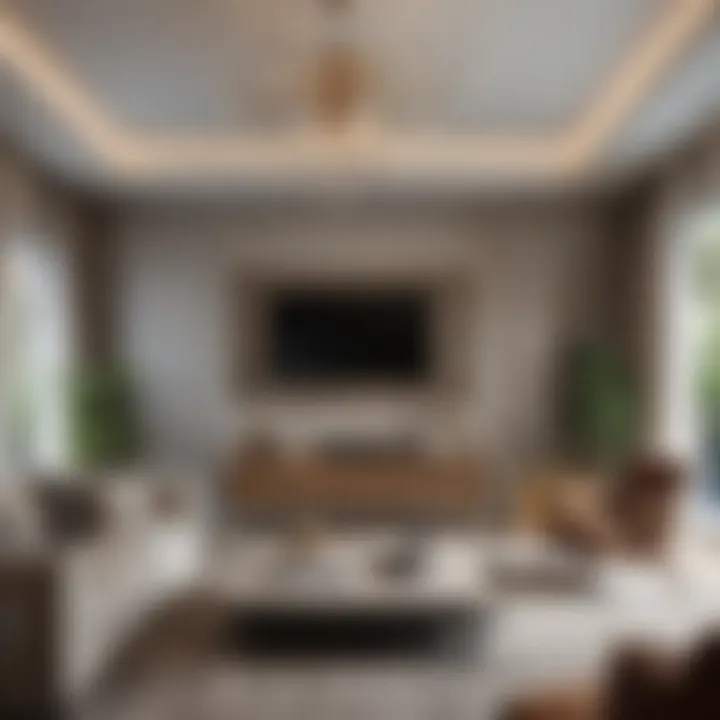
Intro
Creating a living space that reflects both personal style and practical needs is no small feat. From the choice of furniture to color palettes, every detail plays a role in shaping the atmosphere of a home. This article explores the intricate dance between aesthetics and functionality, providing insights into how both elements can coexist harmoniously. As we journey through this topic, expect to find tips, guidelines, and inspirations that will help transform any space into a blend of beauty and usability.
Interior Design Tips
When it comes to interior design, every homeowner should feel empowered to let their unique personality shine through. But how do you make that happen without sacrificing comfort and utility? Here are a few tips that might just do the trick.
Trendy Design Ideas
Staying ahead in the design game doesn’t mean chasing every fleeting trend. Look for ideas that capture your attention, which can be integrated seamlessly with your existing decor. For instance, incorporating natural textures like wood and stone can make a room feel warm and inviting. Or consider bold patterns that can serve as focal points, adding character to a space.
"Design is the silent ambassador of your home.” - Paul Rand
Color Schemes and Combinations
Color doesn’t just shape the visual appeal of your space; it can also affect mood and perception. Choosing the right color scheme can establish a calming atmosphere or create lively energy, depending on what you want. Here’s a guide to a few color combinations:
- Warm Neutrals: Beige, taupe, and soft browns can establish a soothing foundation.
- Vibrant Accents: A splash of teal or burnt orange can transform a monochrome scheme into something lively.
- Pastel Palette: Soft yellows, pinks, and greens can evoke feelings of spring and cheerfulness.
Furniture Arrangement Techniques
Effective furniture arrangement can make or break the functionality of a room. The goal is to create a flow that feels comfortable. Here are some techniques to consider:
- Identify the Focal Point: Whether it's a fireplace, a piece of art, or a view, this is where your furniture should generally be oriented.
- Create Conversation Areas: Arrange seating to facilitate conversation, keeping a distance of about 6-8 feet for comfort.
- Don’t Neglect Scale: Use furniture that respects the size of the room. Overly large pieces can make a space feel cramped.
While the principles of interior design are numerous, it’s important to remember that the ultimate goal is to craft a space that feels like home, representing your lifestyle and interests.
Entertaining Essentials
Transforming your living spaces for gatherings can also be an art form. Here’s to ensuring every occasion is memorable with ease and style.
Table Setting Inspiration
Setting the table for guests can be a reflection of your personal flair. Incorporate elements like seasonal flowers, unique dinnerware, or even textured linens to create an inviting setting. Think about layering—use contrasting plates and vibrant napkins to elevate the overall look.
Menu Planning Tips
Creating an enjoyable menu is central to hosting. Consider dietary preferences and seasonal ingredients. A mix of flavors can cater to diverse palates. Plan for a balance between lighter dishes and hearty options, ensuring everyone leaves satisfied.
Party Theme Suggestions
When hosting, consider a theme to guide your approach. Whether it’s a cozy movie night or a festive brunch, the theme can streamline your planning and enhance the atmosphere. Here are a few themes to help spark inspiration:
- Vintage Garden Party
- Modern Minimalist Gathering
- Rustic Italian Feast
Gardening Know-How
Integrating greenery into your living space helps bridge the gap between indoors and outdoors while promoting wellness. Here’s how to bring a touch of nature inside your home.
Plant Care Guides
Choosing the right plants is crucial. Low-maintenance varieties like pothos or succulents can flourish with minimal effort, perfect for busy lifestyles. Ensure you are familiar with watering needs, light preferences, and soil requirements to sustain their health.
Seasonal Gardening Tips
Seasonality needs to be considered. In winter, resilient indoor plants can thrive, while spring brings the opportunity to refresh outdoor space. Rotate your plants to give them the best chance as seasons change.
DIY Garden Projects
For those with the inclination, creating your own garden features can be fulfilling. Build plant shelves, herb planters, or even vertical gardens using recycled materials to infuse your personality.
Inspirational Home Decor
Decor reflects the soul of a home. To inspire creativity, consider decorating with intention.
Stylish Home Decor Pieces
Investing in unique pieces, whether antique finds or modern art, can serve as conversation starters, while also enriching the aesthetics of your space. Pay attention to textures and colors that resonate with your sense of style.
Wall Art and Prints
Decorating walls with art is not merely about decoration; it’s about personal expression. Whether it’s a large canvas or a collection of prints, they can curate a narrative in your home.
Lighting and Ambiance
Lighting sets the tone. Consider varied sources like pendant lights, floor lamps, and candles. Warm yellow bulbs can create intimacy, while natural light fosters openness during the day.
Outdoor Living Spaces
Turning your attention outdoors creates an inviting experience that extends your home’s livability.
Patio Design Inspiration
Designing a patio should focus on both aesthetics and comfort. Features like cushions, shaded areas, and outdoor rugs can enhance the usability of your space considerably.
Outdoor Furniture Trends
The latest trends include materials that are both sustainable and stylish. Consider durable options like recycled plastic or sustainably-sourced wood that withstand weather conditions without compromising on looks.
Creating Cozy Outdoor Retreats
To foster relaxation outdoors, incorporate elements like fire pits, soft lighting, and comfortable seating. Blankets and pillows can add extra coziness, making it an appealing space for unwinding.
By considering the guidelines explored, you can embark on a journey to cultivate living environments that encapsulate both elegance and functionality. Embrace the flexibility and creativity that comes with designing your space, ensuring it behaves not only as a home but also as an expression of who you are.
Understanding Design Living
Understanding design living is crucial in crafting spaces that are not just visually appealing but also serve their purpose effectively. Every square foot of a home should reflect the personality, needs, and lifestyle of its inhabitants. When we talk about design living, we aren't just discussing the aesthetics; we're exploring a multifaceted approach that integrates functionality and emotional well-being within the confines of four walls.
A well-treated living space can boost mood and productivity, while also serving as a sanctuary for relaxation. The careful consideration of elements like layout, color, and furniture placement can elevate a regular room into a harmonious environment. It’s about making every inch count, striking that fine balance between looking good and functioning well.
"Good design is a lot like clear thinking made visual."
— Edward Tufte
This encapsulates the essence of what design living embodies. It’s about the thought that goes into the choices made, which can resonate throughout the entire home. Furthermore, understanding design living requires us to consider various trends and preferences that evolve with time—each era brings new ideas and innovations that redefine what it means to create a home.
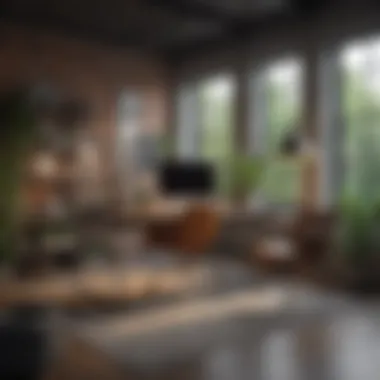
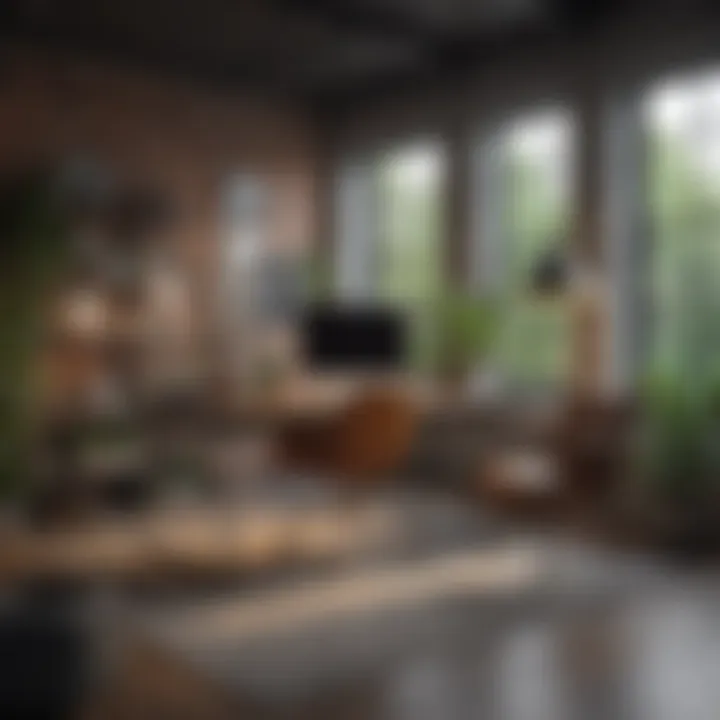
Defining Design Living
Defining design living is to encapsulate it as an approach that marries function and aesthetics in personal spaces. It is not merely about the arrangement of furniture or the choice of colors; it extends to how those choices affect daily activities and the emotional atmosphere of a room.
When defining this concept, it’s helpful to look at a few essential components:
- Functionality: Does the layout accommodate the daily routines of the household? Can it handle the ebb and flow of life, from family dinners to quiet nights in?
- Aesthetic Appeal: Is the space something that brings joy? Do the colors, patterns, and furnishings evoke a sense of belonging and comfort?
- Cohesion: Are the elements in the room working together harmoniously? Does the design flow from room to room without jarring transitions?
In this context, design living becomes a reflection of how individuals interpret their environment, often influenced by culture, personal experiences, and lifestyle.
The Evolution of Interior Design
The evolution of interior design traces a fascinating journey from ancient cultures to contemporary styles. Traditionally, interior spaces were created for utility, functionality, and protection against the elements. However, as societies evolved and wealth increased, the focus began to shift toward aesthetics and personal expression.
- Historical Styles: Early designs were dictated by social status and cultural norms, evident in aristocratic homes adorned with lavish materials and grand furnishings. Each period, from the Rococo of the 18th century to the minimalist movements of the 20th century, has left its mark.
- Modern Influences: In recent decades, there has been a noticeable blending of styles, influenced heavily by globalization and access to various design philosophies. The popularity of open floor plans, sustainability considerations, and a greater emphasis on personal expression have distinguished modern design.
- Technology Impact: As technology advances, so does the capability of homeowners to customize their spaces. 3D-printing, smart home features, and augmented reality tools shape how designers and homeowners visualize what’s possible.
Understanding this evolution provides valuable insight into where current trends may lead. It highlights the importance of flexibility and open-mindedness in design, urging us to consider both the past and future as we shape our living spaces.
The Principles of Effective Design
In any living space, the principles of effective design play a pivotal role. They are like the backbone that supports the whole structure. These principles guide homeowners, designers, and enthusiasts to create environments that are not only beautiful but also functional. Understanding these principles can lead to a more harmonious relationship between aesthetics and practicality. Many people often overlook these concepts, focusing mainly on how things look rather than how they work.
Effective design principles encompass several critical elements. These include balance, proportion, scale, and color theory. Focusing on these aspects can bring clarity to the design process. For example, if you don't have balance, your room might feel off-kilter. Similarly, misjudging proportions can make a space feel cramped or vast.
To truly make a space your own, it’s about intertwining these fundamental principles to shape the environment you inhabit. They are not set in stone guidelines but rather flexible rules that can be adjusted to fit personal tastes, needs, and lifestyles.
Balance in Design
Symmetrical vs. Asymmetrical Balance
When it comes to balance in design, you have two major styles to consider: symmetrical and asymmetrical balance. Symmetrical balance often brings a sense of order and tranquility—think of two identical nightstands flanking a bed. This approach is well-suited for spaces that aim for a more traditional or formal aesthetic.
On the other hand, asymmetrical balance is about harmony without exact mirroring. It’s a delightful dance of elements that vary in size, shape, or color but still maintain equilibrium. For instance, a large piece of artwork on one side of a sofa could be balanced by a cluster of smaller decor items on the other. Both options have their merits, but asymmetry often brings a touch of contemporary flair. Just keep in mind that too much asymmetry can lead to chaos if not handled carefully.
Color Balance
Color balance is another essential ingredient that can make or break a design. When we talk about color balance, we are referring to how colors interact within a given space. A well-balanced palette provides visual comfort and can set the mood of the room. For example, combining vibrant colors with neutrals helps in achieving that dynamic yet soothing look.
Choosing the right color balance means understanding the psychology of colors. Warm colors can bring energy, while cool colors promote calmness. However, overdoing a single color can drown out the room and suffocate its energy. Striking that balance takes a keen eye and some trial and error.
Focal Points
Focal points in design act as the cherry on top of the interior cake. They are features that naturally draw the eye and can transform a mundane space into something captivating. Imagine a fireplace or an oversized piece of art—these are classic examples of focal points that anchor the room.
The key to using focal points effectively lies in harmony. Placing too many competing focal points can create confusion. Instead, allowing one or two to shine through creates a stronger, more cohesive atmosphere. This consideration is important because it can either enhance or diminish the overall feel of a living space.
Proportion and Scale
Human Scale
Human scale revolves around designing spaces and elements that cater to our everyday experiences. Essentially, it’s about proportioning furniture and decor in a way that feels natural to those who inhabit the space. Think about a dining table that is just the right height for a comfortable meal. Get it wrong, and suddenly you have a towering mast instead of a cozy gathering spot.
Emphasizing human scale allows for a more inviting atmosphere. If everything is out of whack compared to human dimensions, the space will feel alien, which is hardly conducive to comfort or joy. It’s this aspect of design that can elevate the utility of any space into a personal sanctuary.
Furniture Arrangement
How you arrange furniture is pivotal. It’s not just about pushing pieces around until they look good; it’s actually about creating flow. When you arrange furniture well, the room practically invites people in and encourages interaction. For example, having a seating area that promotes conversation is much better than creating a maze that keeps guests at arm's length.
Arranging furniture involves considering not just how things look, but how people will interact with the space. Poor arrangements can lead to discomfort and wasted space, while thoughtful ones enhance functionality and aesthetics.
Room Size Considerations
Understanding the size of a room is another key element in effective design. A large open area can feel sparse if not filled with the right proportion of furniture, while small spaces can seem claustrophobic without the right layout. Choosing furniture pieces that respect the scale of the room can make a world of difference.
Paying careful attention to room size makes it easier to determine how to use that space effectively. A space that feels cramped may often be a product of poor sizing and placement decisions.
Color Theory in Spaces
Impact of Color on Mood
Colors can have profound effects on our emotions and moods. This nuance is particularly significant within living spaces, where the wrong choice can lead to feelings of unease or agitation. For instance, blue is often associated with serenity and calmness, making it an ideal choice for bedrooms. On the flip side, yellows can evoke happiness but may become overwhelming if overused.
Recognizing the impact of color on mood allows for better emotional experiences in daily life. It’s essential to think critically about how colors can mesh together to either heighten or calm our feelings.
Color Schemes and Combinations
When discussing color schemes, it's all about the relationships between colors. Complementary colors, like blue and orange, can create tension, while analogous colors, such as blue, green, and yellow, often lead to a more serene vibe. The success lies in how these colors are combined and accentuated.
Finding the right color scheme ultimately enhances the design. It pulls the entire space together and can create a visual narrative. However, being too rigid can lead to monotony. A little experimentation can go a long way in avoiding this.
Accent Walls
Accent walls are a popular choice for adding drama and depth without overwhelming the entire room. They typically one wall in a contrasting color or texture, allowing it to stand out while the others blend softly into the background. An accent wall can help to highlight specific features, like a fireplace or an artwork, thereby guiding the viewer's attention.
The unique feature of an accent wall is its ability to be both bold and subtle. While it can invigorate a space, it can potentially overpower it too—especially if the choice of color or pattern doesn't harmonize with the rest of the room. Therefore, balancing that boldness with the other design elements is crucial.
Creating Functional Spaces
Creating functional spaces is the backbone of effective interior design. It's not just about making a place look pretty; it’s about ensuring that each area serves a specific purpose while remaining comfortable and accessible. When done right, functional spaces enhance both daily life and relaxation, making them essential in any dwelling.
The importance of functional spaces can be seen in countless scenarios – from a bustling family kitchen where meals are prepped, to a cozy reading nook bathed in natural light. Each of these spaces requires thoughtful consideration of layout, ergonomics, and personal habits. A well-designed functional space can increase productivity, reduce stress, and foster a sense of well-being.
Space Planning Techniques
Effective space planning is vital to maximizing functionality. Here are key techniques:
Zoning for Purpose
Zoning involves dividing a larger space into smaller areas designated for specific activities. This approach can help maintain order and streamline how rooms are utilized. Consider a living room that includes zones for watching TV, reading, and socializing. Each zone can be outfitted with furniture and decor that supports its primary function.
A major characteristic of zoning is its flexibility; designers can adapt layouts as needs change. Homeowners often appreciate this adaptable design, fostering a sense of ownership over their environment. The downside of zoning might be that it requires careful planning; poorly executed zoning can make a space feel cluttered or disjointed.
Traffic Flow Considerations
Traffic flow is another significant aspect of designing functional spaces. It refers to how people navigate through a space, which can affect comfort and usability. A well-planned layout considers pathways between furniture, allowing for easy movement and reducing any feeling of congestion.
Smooth traffic flow is often regarded as a fundamental feature of good design. Spaces must support both daily routines and spontaneous gatherings. However, one potential downside is the need to compromise on some furniture layouts to achieve optimal circulation, leading to sometimes less visually appealing arrangements.
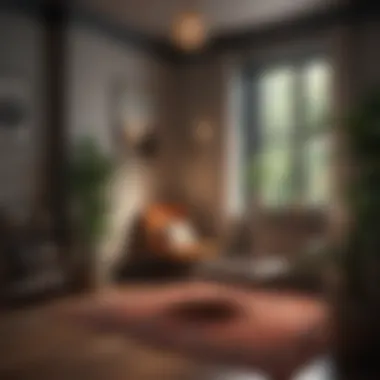
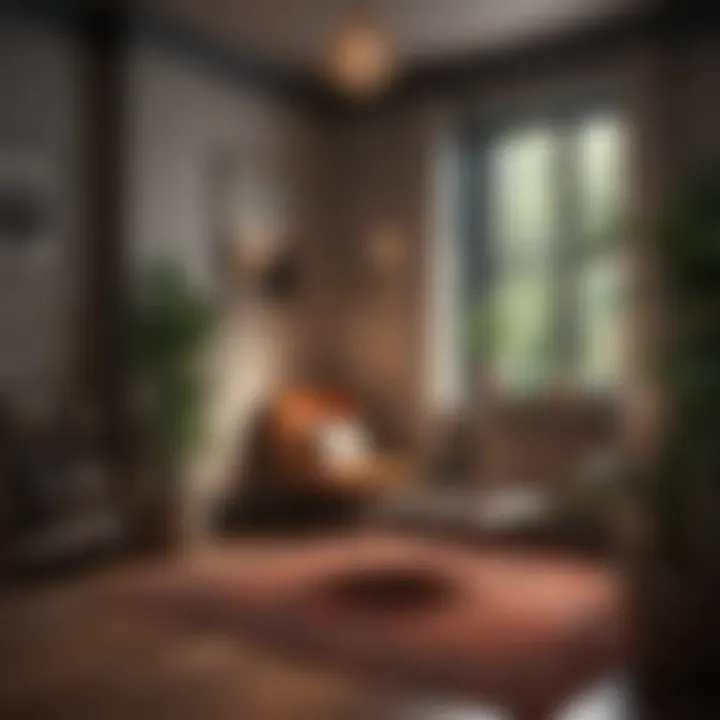
Flexible Spaces
Flexible spaces cater to the dynamic nature of modern living. As lifestyles evolve, the ability to easily reconfigure areas can make a huge difference. A room that can serve as an office during the week and a guest room on weekends exemplifies this versatility.
The key characteristic of flexible spaces is adaptability. Homeowners find this approach particularly appealing, as it allows them to maximize utility without needing additional square footage. Some might argue that this can create a less-defined sense of space, but in reality, a well-designed flexible area can enhance overall functionality immensely.
Smart Storage Solutions
Now turning to storage solutions, it’s no secret that clutter can quickly turn a well-designed room into chaos. Effective storage integrates seamlessly into the living space, thereby enhancing functionality without compromising on aesthetics.
Built-In Options
Built-in storage options, such as shelves or cabinets, offer smart solutions for utilizing often overlooked areas of a home. Whether it’s under staircases or recesses in walls, built-ins can create flow and organization, preserving floor space without losing style.
This design choice is popular for its sleek look and ability to fit any space precisely. Its unique feature lies in its customizability, but it does require upfront planning and, often, investment in quality craftsmanship.
Multi-Functional Furniture
Multi-functional furniture is another clever way to boost both aesthetics and utility. Think sofabeds or coffee tables that convert into workstations. This type of furniture represents a shift towards dual-purpose designs catering to varied needs.
The beauty of multi-functional pieces is that they can transform a space when guests come over. However, some may argue that not every piece can effectively serve dual purposes without compromising comfort or performance.
Decluttering Strategies
Lastly, decluttering strategies play a crucial role in maintaining functional living spaces. Techniques such as the “one in, one out” rule or seasonal reviews can help keep a home organized and livable. This is not just about aesthetics; it’s a practical approach to ensuring homeownership isn’t laden with unnecessary distractions.
The philosophy behind decluttering promotes peace of mind – a valuable trait for any living environment. It’s an accessible choice in an age where minimalism is on the rise. However, the disadvantage might be the emotional challenges some face when parting with belongings, as this process can involve more than just physical space considerations.
By considering space planning techniques alongside smart storage solutions, homeowners can create environments that not only look good but also support their everyday lives efficiently. It’s about striking that elusive balance between style and practicality, tailoring each space to meet unique lifestyle needs.
Incorporating Nature into Design
Incorporating nature into design is an essential aspect of modern interior aesthetics, seeking to weave the outdoors into the very fabric of our living spaces. By establishing a connection with nature, we enhance not only the physical environment but also our mental and emotional well-being. This intersection of natural elements with functional design fosters a sense of tranquility and harmony within our homes, making the spaces we inhabit more enjoyable and fulfilling.
Biophilic Design Principles
Natural Light Utilization
Natural light serves as a cornerstone for any biophilic design principle. It allows spaces to breathe and flourish, promoting positive energy flow within a room. Maximizing natural light can transform a dull interior into a vibrant haven, energizing its inhabitants. One of the key characteristics of using natural light effectively is its ability to change a room's ambiance throughout the day, offering a dynamic experience. This can be achieved through large windows, skylights, or open-concept layouts that encourage sunlight penetration. However, while harnessing natural light can make spaces more inviting, it can also lead to issues like glare or overheating if not managed properly.
Indoor Plant Integration
Integrating indoor plants into design is another remarkable way to bring nature inside. Plants not only add color and texture but also improve air quality and enhance mood. The key feature of indoor plants lies in their diversity; from ferns to succulents, there are options to suit any style or light condition. This choice is particularly popular today as more people opt for greenery to create a calming atmosphere. The unique capability of plants to thrive in various environments allows for creativity in placement. However, it's important to recognize that maintenance might be a drawback for some, requiring time and attention.
Views and Aesthetics
Assessing the views from within a space can profoundly impact its overall aesthetics. Taking advantage of picturesque landscapes or gardens can draw the eye outdoors, adding depth to a design. A notable characteristic of views in design is their ability to serve as focal points, seamlessly blending the interior with the exterior environment. This can uniquely enhance the aesthetic of a home, making it not only a living space but also a sanctuary for the soul. Restful views can inspire creativity and relaxation, fostering a connection to nature. Yet, one must consider privacy and the aspect of external disturbances, which can detract from that peaceful experience.
Sustainable Design Practices
Eco-Friendly Materials
Eco-friendly materials are at the heart of sustainable design practices, ensuring that the design process is aligned with environmental consciousness. By utilizing materials that are renewable, recycled, or low-impact, one can craft spaces that have minimal negative environmental effects. A defining characteristic of these materials is their natural composition, enabling the reduction of harmful emissions. This approach is beneficial because it reduces dependence on non-renewable resources and supports healthier indoor environments. Notably, the challenge lies in finding efficient and aesthetically pleasing options without sacrificing the overall design vision.
Energy-Efficient Systems
Integrating energy-efficient systems into design aligns with the shifting expectations toward sustainable living. These systems, which can include smart thermostats, LED lighting, and energy-efficient appliances, amplify the functionality of a space while lowering energy consumption. A key aspect of these systems is their ability to adapt to user needs while conserving resources. Favorable outcomes from adopting such technology include reduced utility bills and minimal environmental impact. Nonetheless, upfront costs can be a barrier for homeowners, necessitating considerate planning and budgeting.
Reducing Carbon Footprint
When it comes to reducing carbon footprint, each design choice can significantly influence the larger picture of environmental impacts. Implementing strategies like using sustainable transport options, optimizing energy use, and selecting locally sourced materials reflects a strong commitment to reducing one's ecological impact. The key characteristic of this approach is its holistic view of life, recognizing that individual actions contribute to the collective welfare. Emphasizing the imperative to prioritize sustainability fosters a mindful approach to living environments. However, achieving these aspirations can require more effort, planning, and sometimes higher initial investments.
Design Elements that Enhance Living
In the ever-evolving world of interior design, the elements that elevate living spaces can't be overlooked. They play a significant role in shaping our interactions with these spaces. While aesthetics woo the eyes, functionality ensures enduring comfort and usability. Striking the right balance between these two can create environments that truly resonate for homeowners and visitors alike.
Lighting in Design
Lighting is not just a practical necessity; it serves as the unsung hero of design, impacting mood, functionality, and the overall aesthetic of a space. The interplay of various lighting types can dramatically enhance living environments, making them more enjoyable and inviting.
Types of Lighting
Types of lighting can drastically affect the atmosphere of any room. Most spaces call for a mix of ambient, task, and accent lighting, each serving its purpose. Ambient light provides general illumination, making it the foundation of any lighting plan. On the other hand, task lighting focuses on specific areas, such as reading nooks or kitchens, while accent lighting adds character by highlighting artwork or architectural features.
Examples include pendant lights over kitchen islands or wall sconces that showcase paintings. This blend is not just a practical choice but a styling opportunity, allowing creativity to shine, offering uniqueness to every corner. However, poorly designed lighting can lead to glare or harsh shadows, which can throw off the balance of a space.
Layered Lighting Techniques
Layered lighting techniques take this idea further, combining different sources to enhance versatility. This method means using several light sources at varying levels — overhead lights, table lamps, and even candles can all coexist harmoniously. The distinct characteristic of using layers in lighting is that it offers flexibility in mood setting according to the time of day or activity, ensuring function while enhancing the beauty. Understanding how to adjust these layers allows one to highlight decor and provide practical light where needed. However, the downside may include the challenge of keeping balance and avoiding clutter, stressing the need for careful planning.
Color Temperature Effects
Color temperature plays a vital role in setting the psychological tone of a room. The warmth or coolness of a bulb can evoke different feelings—warmer lights are generally more inviting and cozy, while cooler lights promote focus and alertness. This characteristic is crucial in spaces meant for relaxation such as bedrooms and living rooms, where warmth can enhance comfort. But keep in mind, lights are not one-size-fits-all. In utility-focused spaces like kitchens or offices, cooler tones can result in an energizing environment. The trick lies in matching these temperatures with the intended vibe of the area, keeping functionality and aesthetics in perfect sync.
Textures and Materials
Exploring textures and materials takes design to another level, deeply influencing how a space is perceived and functioned. The interplay of different materials can create a layered effect that enriches the sensory experience and enhances both comfort and utility.
Combining Different Textures
Combining different textures in design is akin to composing a symphony; each texture contributes its unique note to the overall ambiance. Soft fabrics like velvet can effectively balance harder surfaces such as glass or metal, creating a harmonious tactile experience. This harmony supports both aesthetic appeal and comfort, making spaces feel lived-in and relatable. A word of caution, though: too many competing textures can lead to chaos, so it's key to maintain a sense of balance. The challenge lies in picking textures that complement rather than clash.
Material Durability
Material durability is a deciding factor in the longevity of a design. When selected carefully, materials not only withstand daily wear and tear but also provide an ongoing aesthetic quality. Durable options like hardwood, stone, and high-quality fabrics withstand pressure from families and pets, ensuring an enduring visual appeal. The essential benefit of prioritizing durability is clear: spaces remain functional and beautiful, reducing the need for frequent replacements. However, sourcing sustainably durable materials can sometimes challenge budget considerations.
The Feel of Space
Finally, how a space feels is the culmination of all design elements working together. This concept transcends mere visual aesthetics, drawing from elements like textures, lighting, and layout to create a comprehensive experience. A well-thought-out feel engages all the senses and evokes strong feelings, from warmth and coziness to openness and tranquility. The right mix can ensure comfort, resulting in a cohesive design that echoes personal expression. That said, it can take time to achieve the desired feel, as one needs to thoughtfully layer elements without overloading the senses.
Design is not just what it looks like and feels like. Design is how it works.
Emphasizing the right design elements can ensure that living spaces are not just visually appealing but also practical, ultimately enriching daily life.
Personalization in Design
Personalization in design is all about making a space uniquely yours, taking into account the individual tastes and lifestyle needs of those who live in it. Every nook and cranny possesses the potential to resonate with personal significance. This is not merely about aesthetics; it intertwines closely with functionality, creating environments where every element feels familiar and serves a purpose. As we dive into the different aspects of personalization, we uncover how it not only enhances beauty but also ensures that these spaces cater effectively to the inhabitants' daily routines and emotional well-being.
Reflecting Personal Style
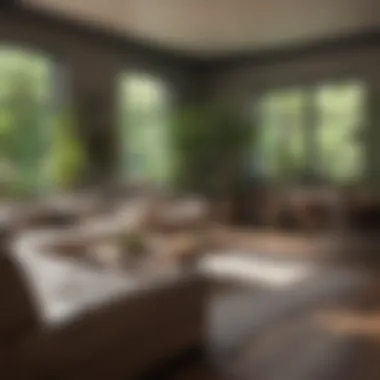
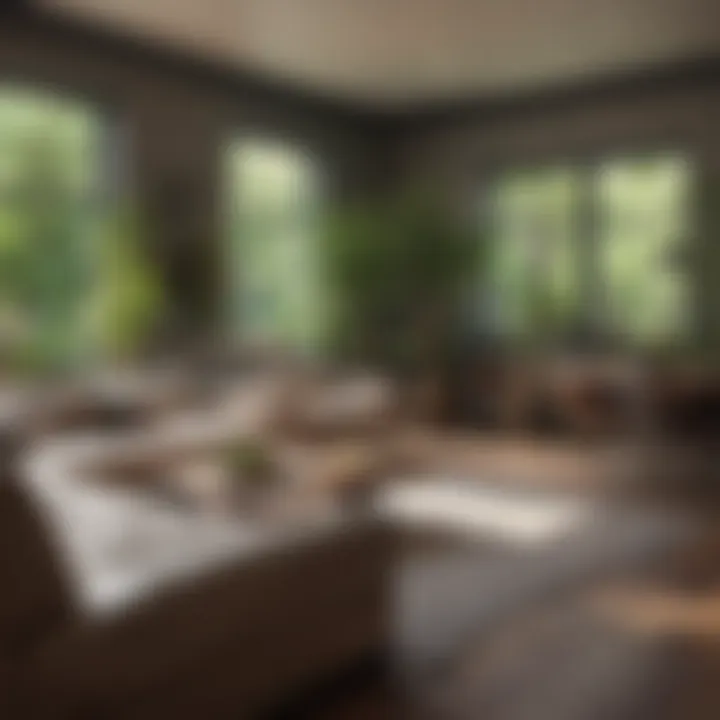
Eclectic vs. Minimalistic Styles
When it comes to style, eclectic and minimalistic approaches stand as two representatives at opposite ends of the spectrum. Eclectic style embraces a rich tapestry of different influences, blending colors, patterns, and textures, creating a vibrant and lively aesthetic. On the flip side, minimalistic design promotes simplicity and functionality, often characterized by clean lines and a restrained color palette.
- Key Characteristic: Eclectic design thrives on variety and personality. It encourages individuals to layer multiple design elements, often making each space a story of its own. Minimalistic style offers a clear advantage in maintenance and a sleek look, which appeals to many.
- Benefits: Eclectic design brings warmth and character to a home, allowing for a very personal touch. Minimalism, conversely, simplifies life by reducing clutter and distractions, catering good to focused living.
- Unique Feature: While eclectic spaces often feel inviting and can invoke a sense of nostalgia, minimalistic spaces aid in fostering tranquility and clarity.
Art and Decor Choices
Art and decor serve as windows into your personality and interests. Choosing the right pieces significantly contributes to how living spaces feel and function. It's about curating a collection that speaks to you.
- Key Characteristic: The choice of art and decor can completely transform a space. Whether it's a bold painting, intricate sculptures, or simple yet meaningful decor items, these elements tie together the overall design.
- Benefits: Incorporating personal art often inspires conversations and creates emotional connections. It turns a stark room into a vibrant extension of oneself. Conversely, decor can easily be overdone, potentially leading to cluttered or confused aesthetics.
- Unique Feature: Art reflects personal history, while decor should ideally complement the space's function, creating a harmonious balance that's both practical and beautiful.
Family Heirlooms and Sentimentality
Family heirlooms weave narratives of love, loss, and memories into the fabric of a living space. Incorporating these special items can add depth to design, but it requires thoughtful placement and consideration of visual quality.
- Key Characteristic: Heirlooms hold emotional value and often serve as centerpiece conversation starters, connecting different generations.
- Benefits: Utilizing sentimental pieces can bridge personal histories, inviting guests into the stories that shaped those objects. The downside can sometimes be the challenge of blending older styles with modern design, which has to be handled delicately.
- Unique Feature: Unlike mass-produced decor, heirlooms possess a unique history that no one else can replicate, adding irreplaceable character to your home.
Adapting Spaces for Lifestyle Needs
Adapting your home to meet the lifestyle needs of its occupants is crucial for ensuring both comfort and usability. This involves understanding not just who lives in the spaces, but how they live.
Designing for Families
Designing for families is about creating spaces that cater to both social interaction and the quiet moments of family life. The layout should facilitate family gatherings yet offer areas for privacy when needed.
- Key Characteristic: Family-friendly spaces need enough room for activities, plus safety considerations, especially where young children are involved.
- Benefits: Effective family designs can enhance bonding and create comfort synonymous with home. On the flip side, the more complex the design, the more potential for chaos if not organized effectively or if materials aren’t resilient to wear and tear.
- Unique Feature: Family-centric designs often contrast the spare aesthetics of minimalism, bringing liveliness and warmth into daily interactions.
Accommodating Pets
Pets add joy and companionship to our homes, but their needs often differ greatly from ours. A well-thought-out design will account for areas where pets can feel at home without compromising on style.
- Key Characteristic: Pet-friendly design considers comfort and convenience, from durable fabrics to practical feeding areas, which makes life simpler for both pets and their humans.
- Benefits: A space that considers pets reduces stress for both animals and owners. However, unplanned designs could lead to significant wear and tear on furnishings.
- Unique Feature: Integrating pet needs provides more than just function—it brings a sense of fun and spontaneity to home design.
Remote Workspaces
With the rise of remote work, many homes now require dedicated workspaces that are both functional and conducive to productivity. Designing such areas means striking a balance between comfort, accessibility, and professionalism.
- Key Characteristic: Effective remote workspaces incorporate ergonomic furniture, adequate lighting, and sound isolation, ensuring the area feels separate from living spaces.
- Benefits: A dedicated workspace often boosts productivity and helps in maintaining work-life balance. If neglected, it can become a source of distraction and feel cluttered.
- Unique Feature: The ability to tailor workspaces to one’s workflow ensures that the setup enhances performance while retaining comfort.
Personalization not only transforms the aesthetic appeal of living spaces but also their functionality, weaving individual stories into every corner.
The Role of Technology in Modern Design
In the ever-evolving landscape of interior design, the integration of technology has redefined how we approach our living spaces. It’s not just about aesthetics anymore; it's about creating environments that enhance our daily lives. By incorporating various technological advancements, we've changed the way we interact with our homes, focusing on convenience, comfort, and security. This section delves into the pivotal role technology plays in modern design, looking specifically at smart home integration and the use of virtual reality.
Smart Home Integration
Automated Systems
Automated systems represent a significant shift in interior design, transforming traditional homes into smart homes. These systems enable homeowners to control various aspects of their environment through a single interface, often via smartphones or tablets. Key characteristics of automated systems include remote access, programmable settings, and user-friendly interfaces. Their popularity stems from the convenience they offer: imagine adjusting the lighting or temperature without ever leaving your couch.
A unique feature of these systems is the capability for customization. Homeowners can tailor their settings to fit their schedules, making energy-efficient choices that not only save money but enhance comfort. For instance, programming lights to dim as evening approaches creates an inviting atmosphere while optimizing energy consumption.
However, a potential drawback is the reliance on technology and the internet; outages or system failures can disrupt these conveniences, causing frustration.
Security Features
Security features in modern homes have dramatically evolved alongside technology. Home security systems now integrate seamlessly with smart devices, offering features like remote monitoring and alerts for unusual activities. The key characteristic of these security systems is their ability to provide peace of mind to homeowners, allowing them to monitor their property from anywhere in the world.
The unique aspect of these security features is the ease of integration with other smart technologies. For instance, front door cameras can sync with mobile apps, sending instant notifications when someone approaches the home.
While these systems enhance security, they also raise privacy concerns. Homeowners must navigate the balance between convenience and the risk of data breaches, making thoughtful choices about how they implement these technologies.
Health Monitoring Technologies
Health monitoring technologies in living spaces are becoming increasingly relevant, especially in today's context where wellness is a priority. These technologies can track everything from air quality to physical activity levels, providing insights that can lead to healthier lifestyles. A prominent characteristic of health monitoring technologies is their ability to offer real-time data, helping residents make informed decisions about their living environments.
One unique feature is smart air purifiers that not only filter allergens but also monitor air quality levels and adjust automatically to ensure a healthy atmosphere. This adaptability is a significant advantage in urban settings where pollution is a concern.
However, these health technologies may not always be accessible to every homeowner. Costs and installation requirements can be barriers that some individuals must consider.
Virtual Reality and Design
Virtual Tours
Virtual tours have revolutionized the way we experience design spaces, allowing potential buyers and designers alike to explore layouts without being physically present. The key characteristic of virtual tours is their immersive quality, enabling users to feel as if they are walking through the space themselves. This aspect is particularly beneficial for architects and designers, as it provides a platform to showcase their work creatively and efficiently.
One unique feature of these tours is their interactiveness; users can often make selections or adjustments in real-time, seeing how different colors or layouts would change the look of a room. Though beneficial, a major disadvantage lies in the technology required to create high-quality virtual tours and the potential for it feeling less personal than a real-world walkthrough.
Augmented Reality in Design
Augmented reality tools allow designers and homeowners to visualize changes to a space in real-time, making design decisions easier and more intuitive. This technology integrates computer-generated images with the real-world environment, giving users an enhanced perspective on how new elements would fit within their existing spaces. Its key characteristic is the immediacy it brings to the design process, often seen in applications that let users project furniture choices into their actual rooms.
The unique feature of augmented reality is its interactive nature, allowing users to move and rotate 3D objects within their spaces before making any purchases. There can be challenges, though; not all users may have the technical skills or resources to utilize such tools effectively.
Client Interaction Enhancements
Client interaction enhancements are transforming how designers collaborate with clients and present their ideas. Tools and platforms that facilitate communication and project sharing can greatly improve feedback cycles, making the overall design process more efficient. The key characteristic here is their ability to streamline workflows, allowing for real-time adjustments based on client preferences.
A unique feature is the use of shared digital boards where clients can pin ideas, colors, or inspirations, making the design inputs more visual and organized. However, a downside is that over-reliance on digital communication can sometimes lead to misunderstandings that would be less likely in face-to-face meetings.
Technology's influence on modern design is irrefutable. It empowers homeowners and designers alike to create highly functional, secure, and personalized living spaces that reflect individual needs and lifestyles. As we move forward, combining aesthetics with the practical advantages of technology will continue to shape the homes of the future.
The End: The Future of Design Living
As we stand at the crossroads of innovation and personal expression, it's evident that the narrative of design living is evolving rapidly. The importance of this conclusion lies in recognizing that the intersection of aesthetics and functionality is not merely a transient trend, but rather a framework that shapes how we interact with our spaces. Homeowners and design aficionados alike must embrace this evolving paradigm.
Emerging Trends and Innovations
- Sustainable Practices
The demand for eco-friendly materials is on the rise. People are looking for options that not only look good but also help preserve the environment. Reclaimed wood, bamboo flooring, and recycled metals are becoming hot tickets in contemporary design. - Smart Home Technology
Technology's role can't be overstated. Automating our spaces with the latest smart home devices is not just about convenience; it's about enhancing the way we live. Systems that allow for remote control of lighting, heating, and security are becoming staples that not only ensure safety but also contribute to energy efficiency. - Flexibility in Design
The modern world calls for multifunctional spaces that adapt to shifting needs. Furniture that can morph from a work desk into a dining table is more than a novelty; it reflects the lifestyle of a generation that values both work and relaxation in the same breath. This kind of adaptability is crucial in a time when we spend more time at home than ever. - Personalized Aesthetics
Lastly, customization has taken center stage. Whether it’s choosing colors that resonate with personal experiences or harmonizing materials that speak to individual tastes, the idea of personalization is reshaping living spaces.
In this sense, the future of design living isn't a one-size-fits-all scenario; it’s a tapestry woven from diverse threads of innovation, sustainability, and individuality.
The Continuous Journey of Personal Space
The journey of design living is continuous, marked by evolution and adaptation. Personal space isn't static; it transforms as we grow. A few elements underpin the ongoing importance of personal space:
- Cultural Influences
We inhabit spaces that reflect our cultural identities. As global influences intermingle, the way we design our homes can incorporate diverse aesthetics and functions, enriching our environments with a broad spectrum of meanings. - Adaptation to Lifestyle Changes
Major life changes—like welcoming a new family member or transitioning to remote work—inevitably alter our spatial needs. Designing spaces that accommodate such changes fosters a sense of security and wellbeing. - Wellbeing and Mental Health
Increasing awareness of the connection between living environments and mental health cannot be ignored. Spaces that feel nurturing, calm, and inviting can have a profound impact on emotional wellbeing, pushing the focus of future designs toward mental health-friendly features.
The continuous journey of personal space is also about making intentional choices. Homeowners have the power to curate environments that align with their aspirations, lifestyles, and emotional needs. By combining personal values with current trends, individuals can design spaces that not only enhance functionality but also elevate their quality of life.
In summary, the future of design living is a promise of exploration and growth. It emphasizes a world where aesthetics seamlessly blend with usability, encouraging individuals to personalize their spaces in a way that feels both authentic and purposeful.







